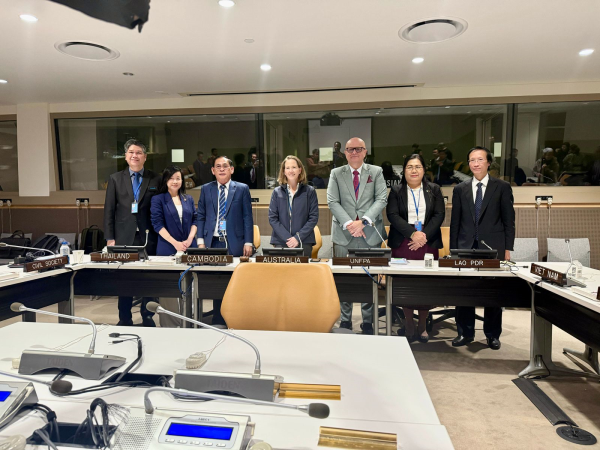KPL
The Lao People's Democratic Republic (Lao PDR) is developing its first Demographic Dividend Roadmap to harness its large working-age population for national social and economic development. This announcement was made by Dr. Viengmany Bounkham, Deputy Director General of the Department of Planning and Finance at the Ministry of Health, during the Mekong Side Event at the 58th Session of the Commission on Population and Development, held at the United Nations Headquarters in New York on April 10.
.jpg)
(KPL) The Lao People's Democratic Republic (Lao PDR) is developing its first Demographic Dividend Roadmap to harness its large working-age population for national social and economic development. This announcement was made by Dr. Viengmany Bounkham, Deputy Director General of the Department of Planning and Finance at the Ministry of Health, during the Mekong Side Event at the 58th Session of the Commission on Population and Development, held at the United Nations Headquarters in New York on April 10.
Dr. Viengmany stated that the roadmap aims to capitalize on the fact that over 60 percent of the Lao population is under 25 years old. She emphasized that this new roadmap will complement the National Population and Development Policy by outlining key interventions to maximize the benefits of the demographic transition.
She was joined by representatives from the Lao Mission to the United Nations, the Ministry of Health, and the Ministry of Planning and Investment, along with delegates from Cambodia, Thailand, and Vietnam, civil society representatives, and other stakeholders.
Supported by the Australian Government and UNFPA, the Mekong Side Event was held under the theme “Mekong Countries Leveraging Gains in Health and Well-being Through Demographic Resilience.” The event aimed to:
-Share achievements and lessons learned from Cambodia, Lao PDR, Thailand, and Vietnam in advancing health and well-being.
-Highlight transformative approaches to integrating population planning into health systems.
-Showcase domestic financing strategies for ICPD commitments.
-Offer actionable recommendations for accelerating the ICPD Programme of Action.
-Identify transferable successes across the Asia-Pacific region.

Dr. Viengmany noted that the Lao roadmap will focus on improving access to healthcare, particularly sexual and reproductive health services, and addressing issues such as malnutrition, early marriage, adolescent pregnancy, and school dropouts. It will also work to close the gap between labor market needs and the education system, enhance skills development, and strengthen social protection mechanisms.
She also highlighted recent national initiatives, including the launch of Laos’ Family Planning 2030 commitments, which aim to expand access to reproductive health services, especially in remote areas. Additional achievements include the increased deployment of trained midwives and the adoption of a rights-based, gender-sensitive approach to health, education, and human capital development.
Despite progress, Dr. Viengmany acknowledged that Lao PDR continues to face significant challenges, such as declining official development assistance and limited fiscal space, which affect healthcare staffing and resources. Climate change and natural disasters further strain the population’s well-being.
“We need to explore domestic and regional financing mechanisms, engage more with our ASEAN neighbors, and expand partnerships with the private sector, which remains an underutilized resource,” she said. “We also need innovative solutions to ensure essential services reach remote communities, through greater engagement with local authorities and grassroots support.”
At the Mekong side event, delegates from Cambodia, Thailand, and Vietnam shared their experiences in implementing their population and development policies. Declining Official Development Assistance presents a significant challenge. It is imperative to employ innovative strategies to mobilize resources, leverage all relevant policy frameworks, and enhance South-South cooperation.
One notable achievement in Cambodia is the establishment of a taskforce comprising 22 key ministries to examine plans aimed at improving the health and well-being of the entire population through the development of a costed multi-ministry Strategic Action Framework on the ICPD. This framework is more than an action plan; it represents a catalytic approach to cross-sectoral discussions to advance health and well-being throughout the population's life cycle.
In Thailand, the 15-year National Population and Development Plan (2022-2037) was developed, highlighting a life-cycle approach to aging with a plan to increase productivity and economic growth while promoting human rights, gender equality, and rights and choices for all, especially women and girls.
In Vietnam, a new comprehensive population strategy for the period 2021-2030 was introduced. This strategy employs a life-cycle approach to address the country's evolving population and development needs. It promotes multisectoral responses across various areas, including sexual and reproductive health and rights, comprehensive youth development, population aging, gender equality, gender-based violence prevention, migration, and demographic dynamics.
KPL